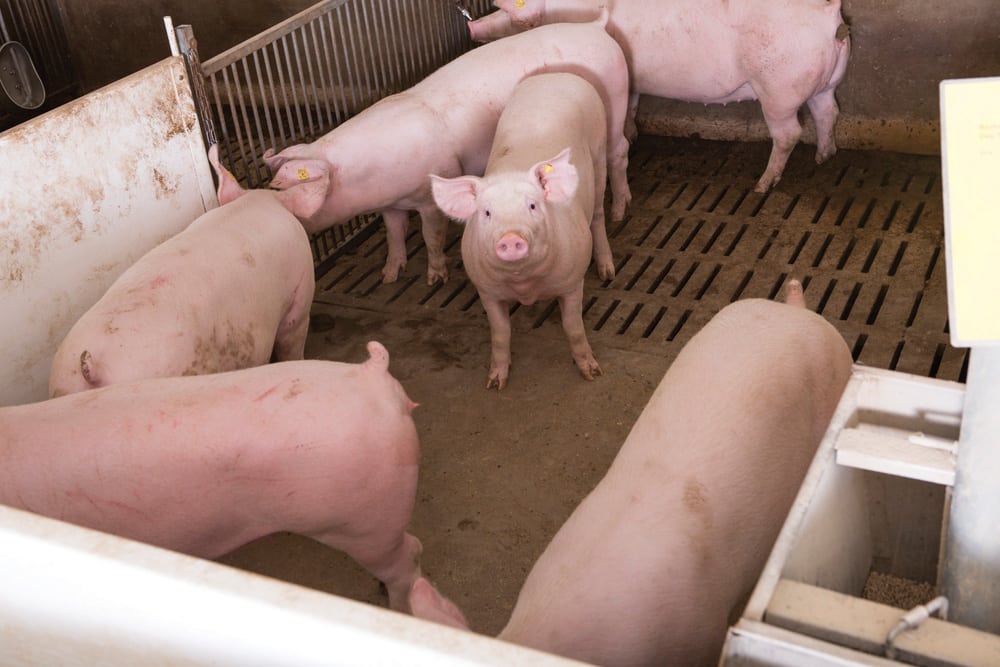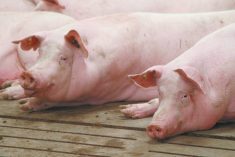Canadian pork producers need “immediate help” from government to deal with a price plunge sparked by U.S. President Donald Trump’s tariff wars with China and Mexico.

“What we’re seeing right now is really bad,” said Darcy Fitzgerald, executive director of Alberta Pork. “And a lot of it has to do with what’s going on with the U.S., China, and Mexico trade tariffs. It’s dropped the price of U.S. pork and we’re completely tied to that.”
Prices plunged 35 per cent in August, according to Saskatchewan government data (before recovering about a fifth of that loss in the first half of September). The situation is most acute in Alberta, where producers are losing $50 on every pig they sell, said Fitzgerald.
- Read more: Canadian hog prices on the rebound
Read Also

Farming Smarter receives financial boost from Alberta government for potato research
Farming Smarter near Lethbridge got a boost to its research equipment, thanks to the Alberta government’s increase in funding for research associations.
For a typical producer, that works out to a loss of $10,000 to $11,000 per week.
About half a dozen producers have called it quits so far and are depopulating their barns, said Fitzgerald. Others are going to reduce their herds or are looking at switching to production of breeding pigs as a way to lower their losses.
“The next three or four months don’t look good for our producers,” said Fitzgerald.
Adding salt to the wound is the fact that having started the tariff war, the U.S. is now subsidizing the hogs driving down Canadian prices.
“Donald Trump started tariff issues with China,” he said. “He recognized that agriculture was going to be affected so he set aside US$12 billion.”
About $260 million of that sum will go to America pork producers, which works out to US$8 per hog.
“For us it would be about $10 and change to be equivalent,” said Fitzgerald. “Twenty-five per cent of the pork that comes into Canada is from the U.S. and now it’s just received a little bit of support from its government. Now it’s being traded in Canada where we don’t have the same support.”
That situation prompted the Canadian Pork Council to call on Ottawa and the provinces to do the same.
“Canadian farmers, facing exactly the same market conditions, need similar support from our federal and provincial governments,” the council said in a news release. “While we can compete and succeed in normal market conditions, we need immediate, short-term support to help weather this storm.”
Government also needs to improve business risk management programs, said Fitzgerald.
“AgriStability does work for some producers but not for others, depending on their margins and how good a year they’ve had or whether they’re 100 per cent into hog production or if they have a mixed farm. That always makes a difference,” he said.
Pork leaders have also been meeting with packers to talk about revamping the pricing system for hogs.
“He (the packer) is making a profit but the producer isn’t,” said Fitzgerald. “We need to work on that in the future so we’re all working together and all getting a fair share of the value of that pig,” he said. “Any time we can work with the packer to look at better programs, I think that’s a good thing to have a better system where we are sharing the profits.”
There is also a shortage of pigs going to the packers right now, he noted.
“Somehow we have to come up with a better solution as to how we price these pigs to keep everybody in the game and grow and make everybody stronger. Maybe this is the time to make that correction. We have very good producers right now. They’re strong and they’re very efficient. But at some point, we have to have a correction in the price.”
The Canadian hog sector also has to do more to promote and brand its pork, he said.
“This industry is one of the most efficient in the world,” said Fitzgerald. “Unfortunately, it receives one of the lowest prices for a high-quality product. There’s more work to do in the industry to brand it properly and get more money for it.”
But the fact remains there is a lot of pork on the market with the U.S. behind much of the surplus.
American hog farmers began ramping up production about three years ago, in part the Trans-Pacific Partnership was expected to significantly boost American pork exports. But one of Trump’s first acts in office was to pull out of that trade deal.
And Canada’s pork sector is highly dependent on exports — it is the third-largest supplier of pork to global markets, with about 70 per cent of production being exported.
The futures markets are now signalling that prices won’t rebound until next spring or summer.
Fitzgerald said he does not blame anyone exiting the industry right now.
“They have to look at that and see — how much can they lose before they call it quits? Or how long will they have to wait until they get their money back? We know there are some producers who are just going to hold off for a while and just see how things go. Others have said they’re just going to stop production for the short term and not accept pigs right now. Some have said they’re going to leave and some have already started the process.”
















